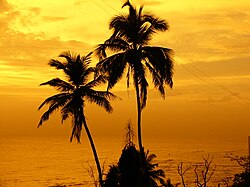This article needs additional citations for verification .(September 2012) |
Land's End | |
|---|---|
Neighbourhood | |
 Sunset at Land's End | |
| Country | India |
| State | Maharashtra |
| District | Mumbai Suburban |
| City | Mumbai |
| Government | |
| • Type | Municipal Corporation |
| • Body | Brihanmumbai Municipal Corporation (MCGM) |
| Languages | |
| • Official | Marathi |
| Time zone | UTC+5:30 (IST) |
| PIN | 400050 |
| Area code | 022 |
| Civic agency | BMC |

Lands End is the southernmost tip of Bandra in Mumbai. The area is notable for being the residence of several Bollywood actors. It is an upmarket area in Mumbai and the properties in this area is one of the most expensive properties in the world. Notable residents include Shahrukh Khan. [1] [2]